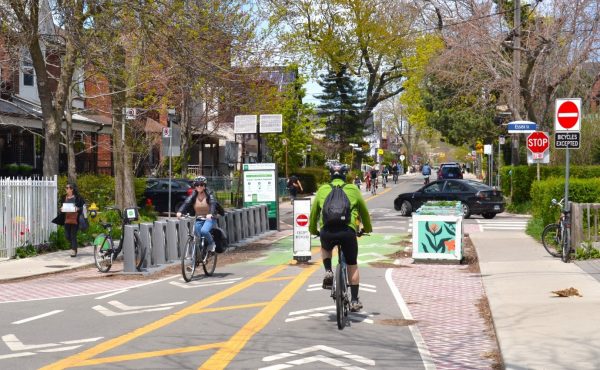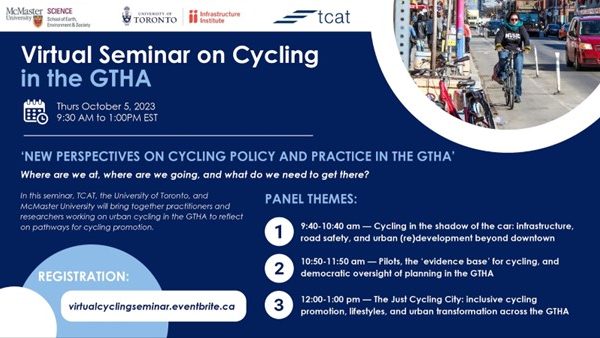Just three days into this year’s Bike Month, a damp May 28th was host to Bike Summit 2009, a day-long conference on cycling policy co-hosted by the Toronto Coalition for Active Transportation (TCAT) and the Clean Air Partnership. International and local presenters covered everything from bike parking to economic and health improvements, sharing perspectives and recommendations that could greatly improve our city’s cycling potential. Spacing will revisit and follow up on some of these ideas, perspectives, and words of two-wheeled wisdom, in hopes of continuing this momentum and encouraging Toronto to actually reach some of the best practices presented at the summit.
![]()
With Bike Month all wrapped up for another year, it seems only appropriate to tackle to question of how our local government can take the reigns from cycling advocates and bike month organizers by promoting cycling through policy. In addressing this topic, a presenter from the Netherlands articulated four clear steps:
1. Getting a completed bicycle network up and running
As it looks increasingly likely that the strike will drag on and delay the installation of the 600km of bike lanes still needed to finish Toronto’s Bike Network, the 2012 completion date may end up being pushed further back. Unless the City’s new requests for money from Ottawa’s $4 billion economic stimulus currently tagged for road repairs include funding for bike lanes, an unfinished bike network will pose a real obstacle for more sophisticated improvements and infrastructure ideas that are often explored on this blog.
2. Having long, uninterrupted bicycle routes and increasing cycling on residential streets
With the Don Valley and Martin Goodman trail as two of the most obvious examples, long stretches of speedy and separated bike routes are the “backbone of modern cycling networks.” Proposals like the West Toronto Railpath and others like it that efficiently move cyclists into a downtown bike network should be encouraged.
In terms of residential biking, Edmonton’s Parkallen neighbourhood demonstrates one effort by a Canadian municipal government to increase bicycling within residential neighbourhoods through incentives and pilot projects followed by recorded results.
3. Creating ways of easily crossing barriers
More pedestrian and bike-friendly bridges (e.g. Humber Bridge), as well as improving underpasses beneath rail lines for bikes from their often discouraging state (e.g. the high-walled north-south streets passing underneath the Dupont rail corridor)
4. Establishing easily accessible and reliable bicycle parking facilities
See the previous Reaching the Summit post on bicycle parking best practices
Drawing on the experience of cycling advocacy in The Netherlands, research studies can hugely influence public and political support for bike infrastructure. For instance, expanding investigations into road safety (or ‘unsafety,’ as it was termed) that includes not merely accidents, but the anxiety many drivers experience that often limits their mobility and reduces their quality of life.
Also, increased exposure to the oil crisis, escalating gas costs and the enormous strain road infrastructure maintenance and repairs cost the taxpayer (especially in our wintery climate) can also make politicians more inclined to promoting cycling.
New laws reducing road speed and increasing driver liability that have made waves in the Netherlands not only for protecting the safety of cyclists, but for road safety in general could also be tried in Toronto. In 1991, an important law was passed making drivers conducting vehicles in the Netherlands that can kill always liable when collisions occur.
Finally, planning for the future by getting kids to feel comfortable on a bike at an early age. This entails making bicycling and bicycle instruction a larger part of a child’s education, establishing safe school routes for children to use and increasing traffic safety enforcement around schools.
Photo by Steve





6 comments
Eminently sensible priority list for building a cycling culture.
But of course, as we all know, its not another report or study or suggestion we need; its action, and implementation.
The key is for government to make a 1 or 2 major steps forward each year, and a host of small ones.
To the Mayor’Credit this year was among the most promising in a while (and hopefully will turn out that way.
1) 70km new bike lanes installed (most important are the major pieces like Lawrence in Scarborough)
2) Adding the West Toronto Rail Path phase 1 thsi year, and the improved MGT by Ontario Place.
3) Delivering the Union Bike Station
Now the key is repeating this success year after year (and bit more too)
Imagine a simple notion
1) Add 70km bike lanes EVERY YEAR
2) Add 10km new off-road Trail EVERY YEAR
3) Add 1 new bike station EVERY YEAR
4) Add bike lockers to every GO Station and most TTC Stations (wherever possible) systematically till complete in say 5 years.
You do that and we will see the growth of the cycling culture here in Toronto. But we all know that; the key is delivering on it.
Though I am all in favour of a more interconnected and larger bike path network I think the City MUST do a better job on maintaining the paths we have. Cycling down the bike lane on Sherbourne is dangerous due to potholes (and the invariable parked cars). The great Don Valley path also needs some work, there are several places in need of repaving, a few areas need to be widened and measures should be taken to drain standing, or flood,water. Just north of the new railway underpass there is a series of unused old wooden ‘telegraph poles’ right beside the path – these look like a hazzard to me, and easy to deal with. A few, quite short, sections need to be added to greatly increase the value of the network – one being the missing link from the Don Valley to the Brickworks. Like many things in life it’s not just the length one should worry about!
The city has to do a better job of fixing the potholes near the curb. It’s summer and I had thought that they would have been filled in before the strike.
Also, more contra-flow bike lanes on the one-way streets (if room).
To be honest, I’ve recently become less concerned with what the city can do for us (which is pretty clear to everyone) and what we can do to gain/retain the city’s support.
I know Miller is hardly the perfect mayor, but he does seem to be pretty pro-bike lane. This whole “war-on-cars” rhetoric is undoubtedly putting a lot of pressure on him, and other pro-cycling councilors. How can we show them enough support that they look like they’re caving in to popular demands, rather than to a minority lobby? And I mean something real, not just waiting to the next election and casting a ballot.
Secondly, with this strike and the TTC/Baird controversy, plus all the other reactionary “scandals” that the right-wing anti-bike councilors are trying to create, isn’t it possible that we might end up with a far more conservative mayor after the next election? How do we make sure we don’t lose momentum if/when such a mayor decides to ignore cyclists, transit, and other things valuable to us?
I hope this doesn’t make me seems a) naive or blindly supportive of miller or b) cynical to expect the backlash to win in the next election. Hopefully Rob Ford will run for mayor, thus ensuring a victory for someone more reasonable.
Hi, Worried,
I understand and agree with a lot of what you said, but it now seems to me that Miller’s fate has very little to do with this “war on cars” stuff. If he can manage to win some major concession from the union, then you can sleep fast because he will be the next mayor. If he can’t, then you really need to worry about a right-winger uses union as the wedge-issue and stands a really good chance to chase Miller out.
I thought this article would be of interest….. http://chrisschnurr.wordpress.com/2009/06/21/guest-blog-where-are-we-going-and-video-the-mayors-motion-on-prbs-for-councillors/ … It focuses on the community of Windsor, Ont., which has been ground zero of the economic contraction in manufacturing…but the points about re-assessing our road network to serve an aging population are important for every community. Aging boomers can become a significant force to encourage active transportation initiatives. Kosowan has written other articles on this topic and believes that there should be a serious dialogue about re-inventing the transportation system.